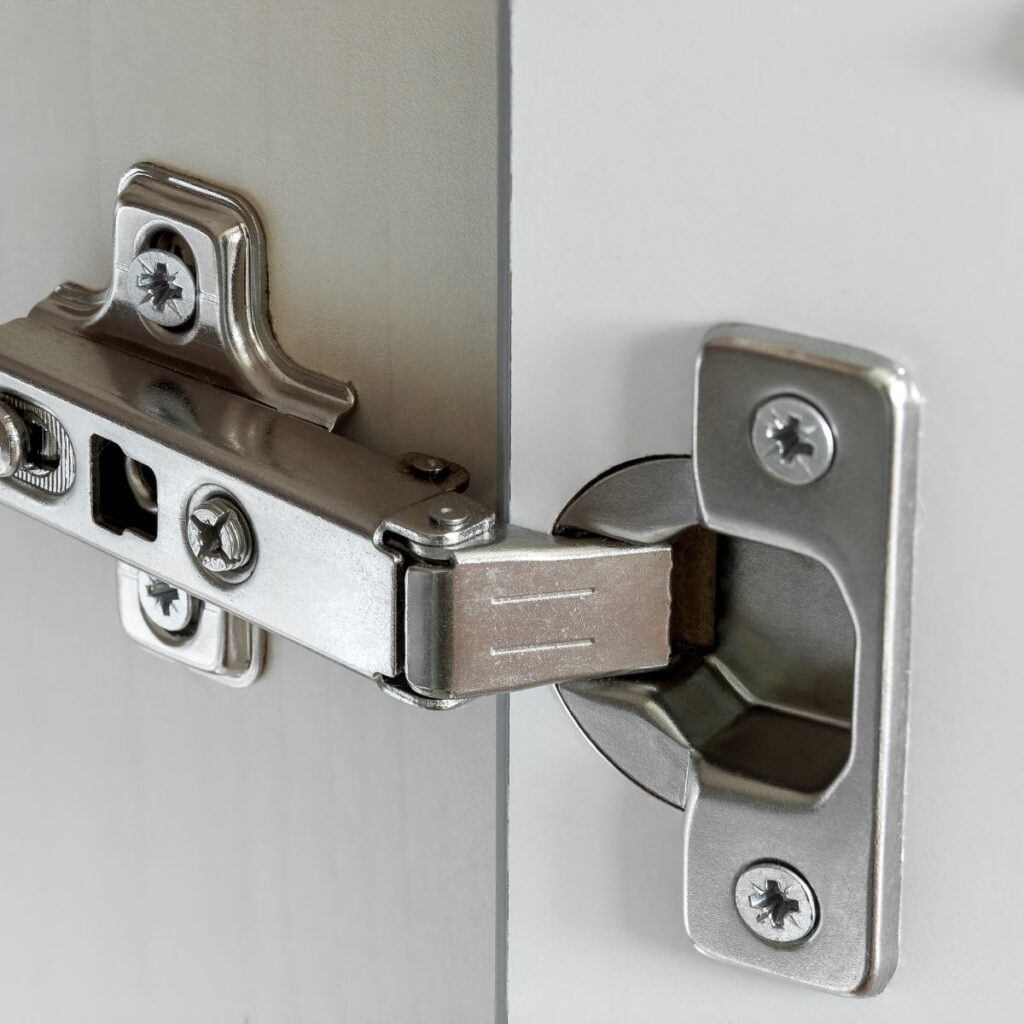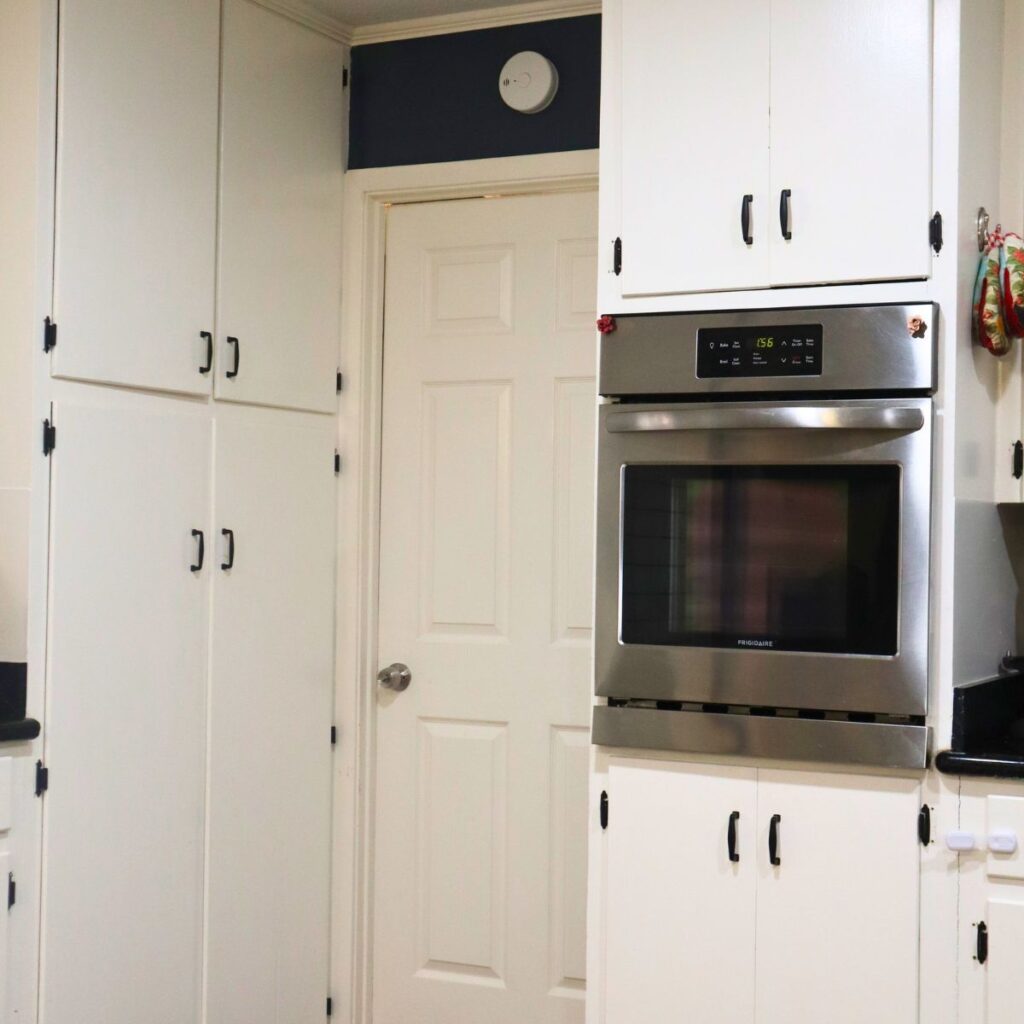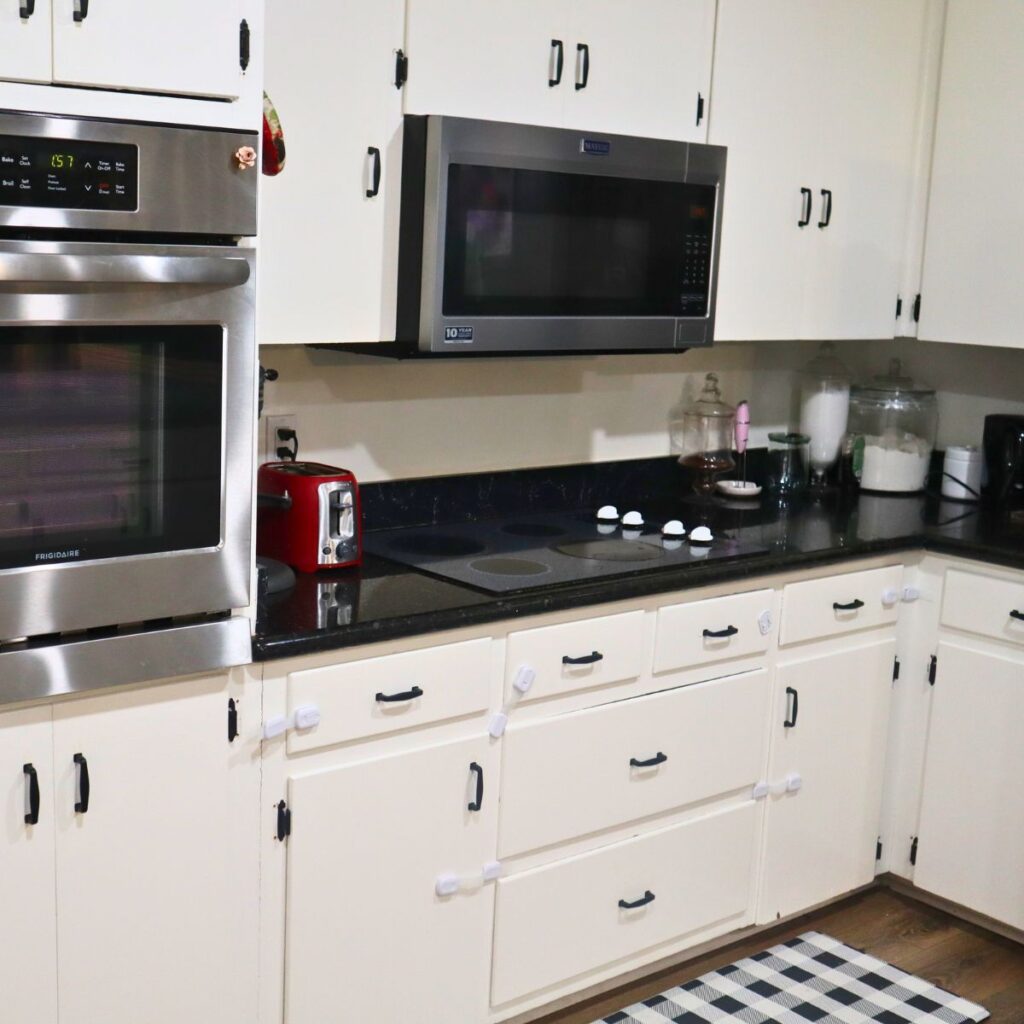When it comes to kitchen cabinets, hinges play a crucial role in both functionality and aesthetics. Choosing the right type of hinge for your cabinets can make a significant difference in how they operate and how they contribute to the overall design of your kitchen. In this comprehensive guide, we’ll explore the various types of kitchen cabinet hinges available, explaining their features, benefits, and suitable applications. Whether you have face frame cabinets, frameless cabinets, or inset doors, you’ll find valuable information to help you choose the best hinge type for your specific needs.

Discloser Note:
This post may contain affiliate links, which means I make a small commission at no extra cost to you. See my full disclosure here.
Table Of Contents

Butt Hinges
Butt hinges are one of the oldest and most common types of hinges used in cabinetry. They consist of two wings, one attached to the door and the other to the cabinet frame, connected by a central pin or barrel. Butt hinges offer a simple and sturdy solution, allowing the door to swing open and closed smoothly. However, they are visible when the cabinet door is closed, and their design may not suit all aesthetic preferences.
Surface Mount Hinges
Surface mount hinges are another popular option for kitchen cabinets. They are installed on the outside of the cabinet door and frame, providing a visible hinge design. Surface mount hinges are available in various styles, including decorative hinges that add a touch of elegance to your cabinets. They are relatively easy to install and offer a wide range of design options to complement your cabinet style.
Concealed Hinges
Concealed hinges, also known as hidden hinges, are designed to be invisible when the cabinet door is closed. They are installed on the inside of the cabinet door and frame, providing a clean and streamlined appearance. Concealed hinges are an excellent choice for those who prefer a seamless and minimalist look in their kitchen cabinets. They are available in different styles, such as European hinges, which are widely used for frameless cabinets.
Overlay Hinges
Overlay hinges are specifically designed for cabinets with overlay doors. Overlay refers to the way the cabinet door overlaps the cabinet opening. There are three main types of overlay hinges: full overlay hinges, half overlay hinges, and partial overlay hinges. Full overlay hinges are used when the door fully covers the cabinet face, while half overlay hinges are suitable for doors that cover half of the cabinet face. Partial overlay hinges are used for doors that only partially cover the cabinet face, leaving a small gap. Overlay hinges offer flexibility in adjusting the door position and provide a clean and modern look to the cabinets.
Inset Hinges
Inset hinges are used for cabinets with inset doors, where the door is set within the cabinet frame, creating a flush appearance. Inset hinges are installed on the inside of the cabinet door and frame, allowing the door to sit perfectly flush with the cabinet face. They offer a high-end and traditional look and require precise installation to ensure proper alignment. Inset hinges are commonly used in face frame cabinets and require more skill and attention to detail during installation.

Soft Close Hinges
Soft close hinges are a popular choice for those seeking a quieter and gentler closing action for their cabinet doors. These hinges feature a built-in mechanism that slows down the closing motion, preventing doors from slamming shut. Soft close hinges are available in various styles, including concealed hinges and surface mount hinges. They provide enhanced safety by reducing the risk of trapped fingers and extend the lifespan of your cabinet doors by minimizing impact and wear.
Pivot Hinges
Pivot hinges are unique in their design, featuring a central pivot point that allows the door to swing open in both directions. They are commonly used for glass doors, allowing them to swing freely without the need for traditional hinges. Pivot hinges offer a sleek and modern look, particularly suitable for contemporary kitchen designs.
Continuous Hinges
Continuous hinges, also known as piano hinges, are long, continuous strips that run along the full length of the door. They provide stability and strength, making them an excellent choice for heavy doors, such as pantry doors or exterior doors. Continuous hinges offer smooth operation and even weight distribution, ensuring durability and reliability.

Demountable Hinges
Demountable hinges offer a convenient feature for cabinet doors that may need to be removed frequently, such as in the case of glass display cabinets or cabinets with removable panels. These hinges allow the door to be easily detached from the cabinet without the need for tools, making maintenance and cleaning more manageable.
Specialty Hinges
In addition to the standard hinge types, there are specialty hinges available to accommodate specific cabinet designs or functionalities. Some examples include corner cabinet hinges, which allow doors to swing open fully in L-shaped or diagonal cabinets, and flipper door hinges, which enable vertical cabinet doors to flip up and out of the way.
Kitchen Door Hinge Types
Selecting the right type of hinge for your kitchen cabinets depends on several factors, including the cabinet style, door type, desired functionality, and personal preferences. Here are some considerations to help you make an informed decision:
- Cabinet Style: Determine whether you have face frame cabinets or frameless cabinets. Face frame cabinets typically use traditional hinges, while frameless cabinets often require European-style hinges.
- Door Type: Consider whether you have overlay doors or inset doors. Overlay doors require overlay hinges, while inset doors need inset hinges.
- Aesthetic Preference: Decide whether you prefer visible hinges or concealed hinges. Surface mount hinges offer a visible hinge design, while concealed hinges provide a seamless and hidden appearance.
- Functionality: Assess the desired features and functionality of your cabinet doors. Soft close hinges are ideal for gentle and quiet closing, while self-closing hinges automatically pull the door closed.
- Installation Ease: Evaluate the level of installation difficulty. Some hinges may require more precision and skill, such as inset hinges, while others offer easier installation, such as surface mount hinges. Click to read more about how to replace kitchen cabinet hinges.
It’s essential to consult with a knowledgeable professional or visit a reputable hardware store to ensure you choose the right hinge type for your specific cabinet design and requirements. They can provide valuable guidance and recommend the best options based on your needs.
Selecting the appropriate kitchen cabinet hinges is crucial for achieving both functionality and visual appeal. By understanding the various hinge types available and considering your cabinet style, door type, and desired features, you can make an informed decision and choose the best hinge type to enhance your kitchen cabinets. Remember to prioritize quality, durability, and ease of installation to ensure long-lasting satisfaction with your cabinet hinges.

Questions About Kitchen Door Hinge Types
How do I determine if my cabinets have face frame or frameless construction?
First, examine the edge of the cabinet door. If you see a visible frame around the edge, it is likely a face frame cabinet. Face frame cabinets typically have overlay doors that partially cover the face frame, leaving a portion of the frame visible. In this case, you will need hinges suitable for overlay doors, such as strap hinges or regular hinges.
On the other hand, if the cabinet door covers the entire face of the cabinet without a visible frame, it is likely a frameless cabinet. Frameless cabinets often have full overlay doors that completely conceal the cabinet box. For frameless cabinets, you will need hinges designed for full overlay doors, such as full overlay hinges or full crank hinges.
Another clue is to examine the hinges already installed on the cabinet doors. If you see hinges mounted on the edge of the door, it is likely a face frame cabinet. These hinges are typically visible and may include features like soft-close hinges for a smooth closing motion.
In contrast, if the hinges are mounted on the inside of the cabinet door, it is likely a frameless cabinet. Frameless cabinets often use concealed hinges, which are hidden when the door is closed. These hinges may have a mounting plate attached to the door wing and frame wing, allowing the door to be adjusted and held securely in the closed position.
You can also consider the overall style and construction of your cabinets. Face frame cabinets are more common in traditional or transitional designs, while frameless cabinets are popular in contemporary or modern styles.
By examining the edge of the door, the presence of a visible frame, the type of hinges already installed, and the overall style of the cabinets, you can determine whether your cabinets have face frame or frameless construction. This knowledge will guide you in choosing the right cabinet hinges for your specific cabinet type, ensuring a proper fit, easy installation, and smooth operation.
Can I mix and match different types of hinges within the same kitchen?
Yes, it is possible to mix and match different types of hinges within the same kitchen, depending on your specific needs and preferences.
When considering mixing different hinge types, it’s essential to ensure they are compatible with the cabinet style, door type, and overlay dimension. For example, if you have a combination of full overlay doors and inset cabinet doors, you would need to select hinges suitable for each door type. Full overlay doors typically require full overlay hinges, while inset doors require inset hinges.
When mixing different hinge types, it’s crucial to pay attention to the weight and size of the cabinet doors. Some hinges, such as full crank hinges or heavy-duty barrel hinges, are designed to support heavier doors. If you have lower cabinets or large doors that require additional support, you can consider using these hinges in combination with regular hinges for the rest of the cabinets.
Another consideration when mixing hinge types is the aesthetic cohesion of your kitchen. While it is possible to have different hinges, it’s generally recommended to maintain consistency in terms of finish and style. For example, if you choose stainless steel hinges for one set of cabinets, it’s a good idea to use the same stainless steel finish for the other hinges in the kitchen. This helps create a cohesive and unified look.
What are the benefits and drawbacks of visible hinges versus concealed hinges?
Visible hinges and concealed hinges offer different benefits and drawbacks, depending on your preferences and the desired aesthetic of your cabinets.
Visible hinges, such as strap hinges or regular hinges, have the advantage of being easy to install and adjust. They are often surface-mounted on the edge of the door and the face of the cabinet frame, providing a visible hinge design that can add a decorative touch to your cabinets. Visible hinges come in a variety of styles, including flush hinges, which sit flush with the surface of the door, and soft-close hinges, which offer a gentle closing action.
One of the main benefits of visible hinges is their accessibility for adjustments. If your cabinets have face frame construction, visible hinges allow you to fine-tune the alignment of the doors and compensate for any slight variations. They also make it easier to remove and replace doors if needed, as the hinge mechanisms are readily accessible.
However, a drawback of visible hinges is that they can disrupt the clean and seamless look of cabinet doors, particularly if you prefer a minimalist or contemporary aesthetic. The hinges are visible when the cabinet doors are closed, which may not suit everyone’s design preferences.
Concealed hinges, on the other hand, offer a hidden hinge design that provides a clean and streamlined appearance. These hinges are mounted on the inside of the cabinet door and the frame wing, making them invisible when the doors are closed. Concealed hinges often use a mounting plate attached to the door wing, allowing for easy installation and adjustment.
One of the main benefits of concealed hinges is their ability to create a seamless and minimalist look. They allow the focus to be on the cabinet doors themselves, without the distraction of visible hinge hardware. Concealed hinges are commonly used in frameless cabinets, where the full overlay doors completely conceal the cabinet box.
However, concealed hinges may require more precise installation and adjustment compared to visible hinges. They typically have specific overlay dimensions and require accurate alignment to ensure the doors sit properly in the closed position. Concealed hinges also have a variety of types, such as barrel hinges or butterfly hinges, offering different features and functionality.
Can I retrofit my existing cabinets with a different hinge type, or do I need to consider it during the initial cabinet design?
Yes, it is possible to retrofit your existing cabinets with a different hinge type, even if it was not initially considered during the cabinet design. Retrofitting allows you to upgrade the functionality and aesthetics of your cabinets without the need for a complete redesign.
When retrofitting hinges, consider the type of cabinet door and the specific features you desire. For example, if you have full overlay doors and want a concealed hinge look, you can replace the existing hinges with full overlay hinges that have a concealed design. Similarly, if you have partial overlay doors and prefer a semi-concealed hinge look, you can opt for semi-concealed hinges that fit within the existing door frame.
Invisible hinges can also be retrofit into cabinets, providing a sleek and minimalistic appearance. These hinges are installed on the inside of the cabinet door and frame, creating a clean and hidden look when the door is closed. Retrofitting invisible hinges may require some adjustments to the door frame and hinge positions, but it can be done to achieve the desired aesthetic.
Consider the weight of the door when retrofitting hinges, as certain hinge types, such as spring-loaded hinges, are designed to support heavier doors. Ensure that the new hinges can handle the weight of your cabinet doors to maintain optimal functionality.
Retrofitting hinges may involve removing the existing hinges, filling any old hinge holes, and installing the new hinges. It’s important to choose the right size and style of hinges that fit the existing cabinet door and frame. Additionally, pay attention to the compatibility between the new hinges and any existing drawer slides or other hardware in the cabinet.
Can I find hinges in different finishes or materials to match my cabinet hardware?
Yes, you can find hinges in different finishes and materials to match your cabinet hardware. Cabinet hinges are available in a variety of finishes, such as polished brass, brushed nickel, chrome, antique bronze, and black, among others. These finishes allow you to coordinate the hinges with your cabinet hardware, such as knobs, handles, or pulls, creating a cohesive and unified look in your kitchen or bathroom.
In addition to finishes, hinges are also made from various materials, including stainless steel, brass, zinc alloy, and iron. Each material offers its own unique aesthetic and durability characteristics. For example, stainless steel hinges provide a modern and sleek appearance, while brass hinges add a touch of elegance and sophistication. Zinc alloy and iron hinges are often more cost-effective options and can be finished to resemble other materials.
When selecting hinges to match your cabinet hardware, consider the style and color of your hardware. For a seamless match, choose hinges with the same finish as your hardware, creating a unified and harmonious look. If you prefer a contrasting look, you can opt for hinges with a complementary finish that adds visual interest and dimension to your cabinets.
It’s important to note that the availability of specific finishes and materials may vary depending on the hinge type and brand. Therefore, it’s recommended to explore different suppliers, hardware stores, or online retailers to find a wide selection of hinges that offer the desired finishes and materials to match your cabinet hardware.

Leave a Reply